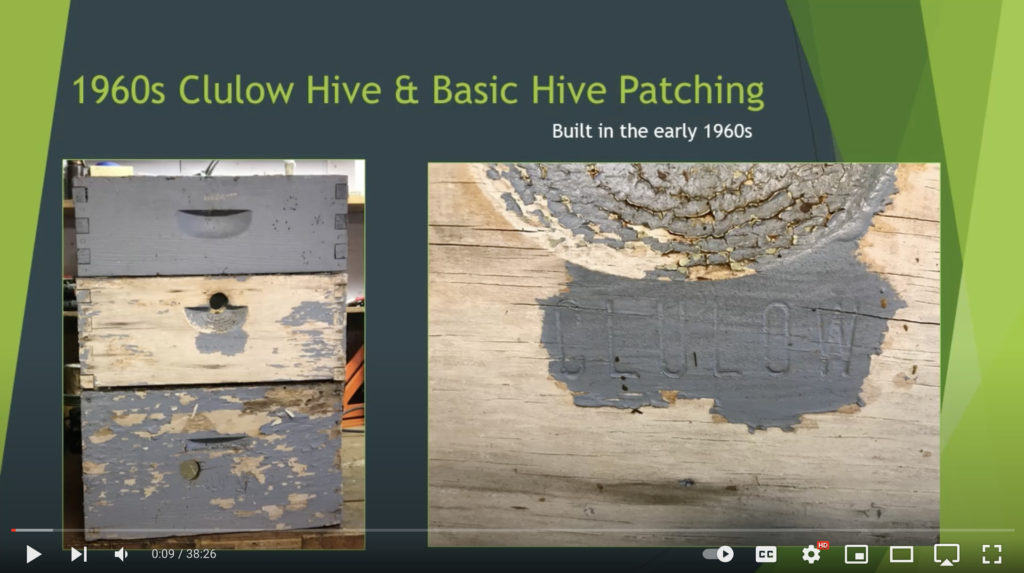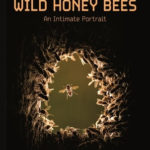
Printable edition
- President’s Message, February 2022
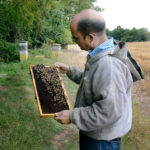
Hello fellow beekeepers,
I would like to take this opportunity to introduce myself to our MSBA members, and tell everyone how excited I am for our future.
For those that don’t know me, my name is Fred Smith. I am a lifelong resident of Washington County and am blessed with a loving wife and son. I am a third-generation beekeeper, and very proud that my son is the fourth generation.
Together, we manage approximately 700 hives across multiple apiaries in Maryland and Delaware. Our primary focus for our colonies is with pollination. Our season starts with apples in Maryland, Virginia, and West Virginia, moves to New Jersey for blueberries, and finishes along Maryland’s and Delaware’s beautiful shores for cucumbers, and watermelons. Chances are that if you’ve enjoyed a watermelon in the summer or an apple from one of Maryland’s many orchards, you’ve enjoyed the fruits of labor of one of our bees. I count everyday as a blessing that I am so fortunate to be able to work with and learn so much from my bees. I’m happy to share my passion with you all.
I’m also very honored and humbled to be the president of MSBA. As such, I’d like to take this opportunity on behalf of all MSBA members to thank Kim and her fellow board members for navigating us through difficult COVID times. Their amazing devotion, countless hours, and heartfelt efforts to this organization will pay dividends for years to come. We owe you our gratitude: many thanks.
You may not realize how much work goes on behind the scenes to run this Association. As such, I’m excited for the future of MSBA and our many great local beekeeping associations.
I’m happy to hear all the great news about associations creatively offering short courses either in-person or with hybrid opportunities. While beekeeping can be large, with hundreds and thousands of colonies, for many it remains a passionate hobby fueled by a bond and love for an amazing insect.
I’m happy for the keepers of the bees to see this camaraderie opening back up, and I’m happy for the bees who benefit from it as well. I’m looking forward to the many great upcoming educational opportunities MSBA will have in 2022 as well as the connections and information sharing these events provide.
Please feel free to stop me at any of our gatherings. I’d love to share with you how my bees are doing, and I’d love to hear how your bees are too.
Wishing everyone and your bees a healthy, prosperous 2022.
Fred Smith
Notes from the Apiary Inspector
- Notes from the Apiary Inspector
Cybil Preston, State Apiary Inspector, MDA
Maryland Apiary Statistics, 2021 versus 2020!
2021 2020 Beekeepers 2,335 2,160 Apiaries 2,932 2,706 Colonies 18,592 16,494 Inspections 241 192 The Maryland Department of Agriculture sent out the annual Apiary Inspectors Fund and registration letter in December to all beekeepers who have been active in the last 5 years. Please send in or email me your signed registration if you have not already done so!
The option of scanning or electronic return seemed to be fairly popular and convenient for some: I am in favor, too! I have personally processed a little over 600 electronic returns so far. We will be doing a second mailing on February 14th...to be sent to those who did not return the 1st registration. We make up our Inspectors lists by the middle of March, and apiary registrations are critical to planning, so please get your registration forms in ASAP! Again, please send in or scan me your updated form, email address is cybil.preston@maryland.gov!
With the long stretches of cold weather (temps too cold for the bees to move to the food stores), I am inspecting more dead outs. Bees that were weak or had smaller clusters were unable to move to the food. The classic signs of starvation are heads in cells and or dead on the inner cover. You could ask, "Why were the clusters so small?" This is an excellent topic of conversation and thought for the off season when looking at this year's management decisions.
This cold weather has been good for K-9 inspections, however. So far Mack and Tukka have inspected and certified 2,000 colonies so far this winter!
Please remember: if you are purchasing nucleus colonies from out of state, you will need to have them inspected prior to them entering the State of Maryland. Also, for nuc suppliers please contact me to get on the inspection request list.
If nucs are made in Maryland and sold to an out of state beekeeper, they must be inspected before movement across state lines. The beekeeper selling nucleus colonies is responsible for finding out from the buyer where they are going.
I am also asking bee clubs to vet their lists of suppliers. If you are publishing a list of local beekeepers who are selling nucs or packages, please be sure the supplier is currently registered with the MDA. Just send me your list and I can cross reference it with the database. This is also true if you wish to use the Bee Check voluntary mapping site: We must have a current registration form on file for you to utilize this free service.

Cybil Preston
Chief Apiary Inspector
State Apiarist
EAS Certified Master Beekeeper
Maryland Department of Agriculture
50 Harry S. Truman Parkway
Annapolis, Maryland 21401
cybil.preston@maryland.gov
(410) 841-5920(O)
(410) 562-3464 (M)
Nucs and Splits Class for MSBA Members February 26
- 2022 February 26 Nucs & Splits CLASS
NOTE: This is an IN-PERSON Class. Mandatory Covid protocols are listed below.
SOLD OUT
Stay UP-TO-DATE on MSBA Meetings and other opportunities - Subscribe to MSBA Announcements. Click HERE
LOCATION: Montgomery College
ADDRESS: 51 Mannakee St, Rockville, MD 20850
BUILDING: Science West (See campus map below)
ROOM: 301 (turn right at the T-Rex in the atrium)
DAY: Saturday, February 26, 2022
TIME: 8:30AM - 4:45PM (Doors open at 8:00 AM)
COST: $50/person (Only Current MSBA members may enroll. To Join MSBA, click here)
LIMITED: Only 50 students may enrollCOVID MANDATES
All attendees must wear masks covering mouth and nose, per Montgomery College guidelines. (teachers may remove masks while teaching)
Please keep fellow beekeepers safe. To protect our teachers and members, if you are feeling ill, or suspect you were exposed to Covid, DO NOT COME - we will refund your money in full.FULL Day of Learning:
TIME Duration What is Happening! Instructor 8:00 0:30 Room is open for arrivals 8:30 0:30 Intro to class, administrivia, Why Split? Advantages of splitting. Timing in Maryland Kim Mehalick 9:00 0:45 Scientific reason for splits: Varroa control; Healthy hives; Statistical Information from BIP Nathalie Steinhauer 9:45 0:10 *** BREAK 9:55 0:45 Even and walkaway splits Mark Dykes 10:40 0:45 Snellgrove method Kim Mehalick 11:25 1.00 *** LUNCH 12:25 0:40 OTS method David Clark 13:05 0:40 Making a nuc in your own yard: what to look for when you purchase one Mark Dykes 13:45 0:45 Sustainable Apiary Larry Truchon 14:30 0:10 BREAK 14:40 0:45 Nuc Production Jim Frasier 15:25 0:45 Overwintering Nucs, Using Animal Husbandry Best Practices, Nutrition... Jason Hough 16:10 0:30 Final Q and A with instructors REMEMBER to:
+ bring your lunch, you will not have time to leave to purchase food
+ be prepared to take good notes. This class will not be recorded.
+ bring your mask
+ To enroll you must be an MSBA member
+ To enroll, you must be LOGGED IN to this website
+ When all 50 seats are purchased, the enrollment page will say "Sold Out", and you will not be able to add the class to your shopping cart.SOLD OUT
IF the button above isn't working, ensure that:
- You are logged in (log in tab is at the top of every page)The Nucs and Splits class will be in the Science West Building, marked SW on this campus map:
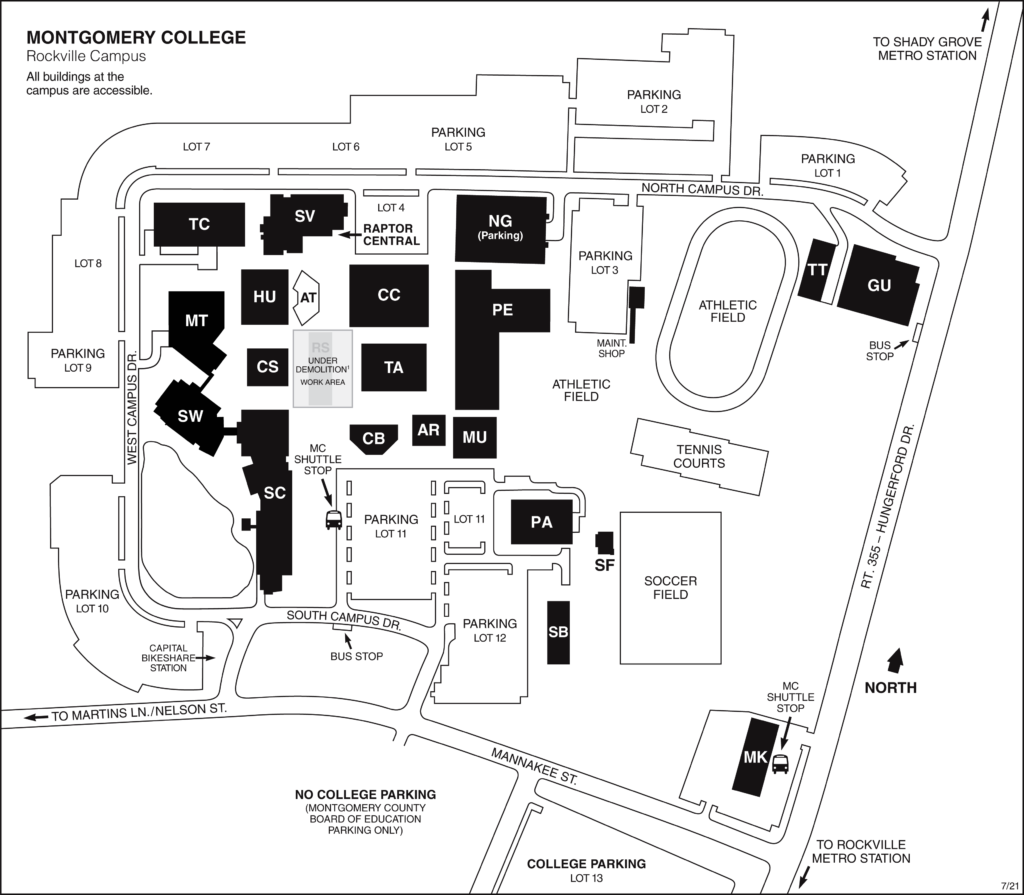
Tips for Buying Bees
- Tips for Buying Bees
Purchasing a nucleus colony is an investment. The questions below are designed for purchasers of nucleus (nuc) colonies to ask of sellers so the buyer can better understand the history, health, and makeup of the nucleus colonies they intend to purchase. The more information the buyer has about the nuc they intend to purchase, the better they will be able to plan to receive the colony and manage it.
Questions to ask of sellers of nucleus colonies prior to arranging a purchase:
● (1) Ask the seller, “Have these nucs (or mother colonies from which they were made) been inspected by the state apiary inspector? “
- Notes for purchaser: Inspection is not legally required for in-state sales in Maryland, but it is an important step to safeguard your investment. Inspections will help ensure your nucleus colony is free of American Foul Brood (AFB). Inspection by the Maryland Department of Agriculture is free of charge.
● (2) Note the kind of equipment you have (deep or medium woodenware) and order a nuc to match. If you plan to use other hive styles (e.g., Layens, top-bar, Warré, other), the Langstroth frames in a nuc will not fit in your hive. You will need to acquire bees as a package or by catching and installing a swarm.● (3) Nucleus colonies can come in different sizes and configurations. You will want to know what you’re buying. Ask the seller, “What is your definition of a nuc? How many frames of brood? How many frames of food (pollen and honey)? Will the nuc contain empty drawn frames or undrawn frames?”
- Notes for the purchaser: The general guidelines for a five-frame nucleus colony are:
- All frames in the nucleus colony should be of good quality. Your nuc may have a mixture of wooden and plastic frames with natural or plastic foundation.
- It should contain at least three frames of brood of various ages.
- It should contain five frames covered with bees clinging to the frame surface.
● (4) Nucleus colonies can be created in a number of different ways. Sometimes the nucleus producer will pull frames of bees and resources from multiple colonies and add queen in a cage. Other times the queen in the colony is the mother of all of the bees in that colony. Some start nucs from packages of bees where they take the risks, and ensure the purchaser receives a good laying queen, with an organized colony before selling a fully operational nuc. Ask the seller, “How were these nucs made up? Was the brood in this colony laid by this queen? Are the bees in this nuc the offspring of this queen? Or were frames of brood, resources and the queen sourced from multiple hives?”
- Notes for the purchaser:
- If the queen in the colony is the mother of all the bees in the colony, then you will know how well she is laying based on the brood pattern in the nucleus colony and the temperament of the colony.
- If you purchase a colony containing a queen that is in a queen cage, she is a new introduction to the colony. Be sure to get instructions from the seller about how to install the nucleus colony into your full-sized woodenware to ensure the queen cage is properly positioned for the queen to be accepted by the colony. Sometimes caged queens are not accepted by the colony so be sure to ask the seller how they will get you a new queen to replace the queen if the caged queen is not accepted.
- If your queen appears undersized, and you are told to wait a few weeks so she will be easier to see, you have a colony with a virgin queen or a very young queen that just began to lay. Ask your nuc seller to provide instructions on how to know that your young queen is established and productive.
● (5) You may want to know more about the history and health of your queen. Ask your seller, “What is the background of this queen? When was she mated? How old is she? Is she marked to make her easier to see?” If your provider claims special provenance for their queens, ask for details.
● (6) You will want to know the history of any mite treatments the seller has performed on the nucleus colony (or on the mother colony from which the colony was made). Ask the seller, “What mite treatments have these bees received, if any, and when?”
● (7) Ideally your colony received a treatment in winter. Your colony may have also received a mite treatment in the spring. You will want to do a baseline mite count a few weeks after your nuc is established in your apiary.
● (8) You will need to know which date to expect your nucleus colony to be ready for pickup and whether you need to put down a deposit to reserve your nuc. Ask your nuc provider, “By what date can I expect to pick up my nuc?” Sometimes providers aren’t able to meet the deadline so ask about their refund policy. For example, if your nuc provider is unable to have your nucleus colony ready for pickup by May 21, you should be able to ask for a full refund.● (9) You will need to plan for transport of your nucleus colony. Ask the seller, “What container will the nuc arrive in? Will you need to return the nuc box to the seller? Or will the seller provide delivery and installation of the nucleus colony at your hive upon request?”
● (10) There may be other things you will need to know for pickup of your nucleus colony. Ask the seller, “On pickup day, what do I need to bring to collect the nuc? Should I bring a veil? Are there any other things I should know or have prepared prior to collecting the nuc?”
This document is provided to start good conversations between sellers and purchases of nucleus colonies. May you be successful in growing your apiary.
Kim Mehalick
Debbie Hewitt
Charles DeBarber: Baltimore's Beeky Geek
- Check out Baltimore’s Beeky Geek
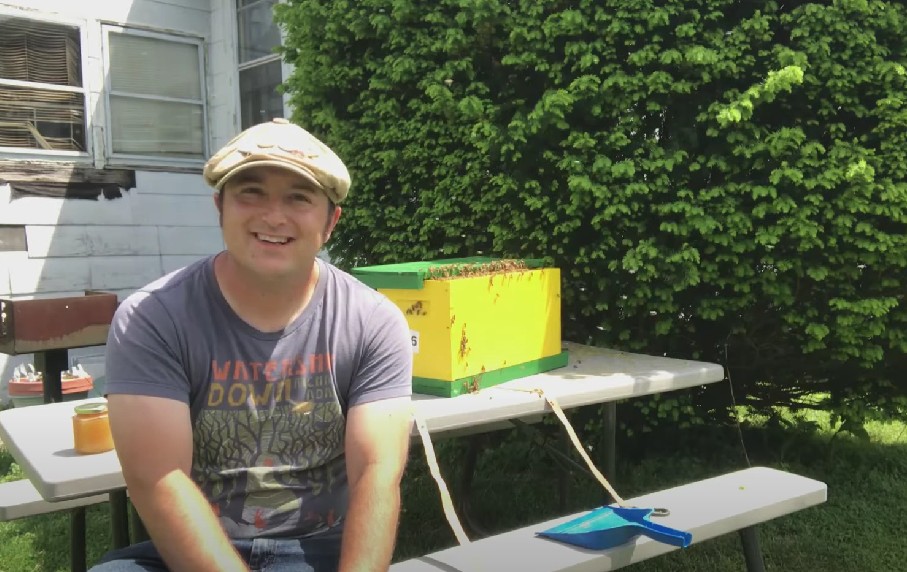
Charles DeBarber Charles DeBarber and the amazing world of antique bee gear restoration
Charles DeBarber of the Filbert Street Garden (and apiary) in Baltimore and the Beeky Geek Youtube channel calls himself "A beekeeper who just loves to restore old hive equipment." His respect and affection for these old tools is evident in the skill and care he uses to bring them back to service.
In his very well produced videos, you can see him remove fragile old leather from a bellows, carefully replicate the piece from a modern day Goodwill find, and place it nail-by-nail into the original metal brackets. Who else seeks out (and finds!) a clockmaker in order to repair an old German clockwork smoker? Who knew that there even were clockwork smokers? DeBarber did.
Charles calls himself "a fanatic for A.I. Root equipment." "I collect bee equipment from all around the world, but I'm a big A.I. Root fanboy."
Depending on the piece, Charles not only returns the tool to functional life: in the case of an old copper Ruddy Smoker, he also cleaned and polished it almost to its original mail-order self. He sprinkles his work with insights into the history of bee gear, design choices made at the time, and how tools changed and why.
Midwinter renovations and recreations
During this part of the year, when we are often introducing our short course students to all the shiny new gear and pristine veils in the beekeeping catalog, Charles is doing something different: He is using the off-season (the only free time he has for painting and nailing and gluing) to patch old hive woodenware. In some cases, he has brought items more than 60 years old back into service, including a hive was built by the late Reverend Clulow, a founder of the Anne Arundel County Beekeeping Association in Central Maryland.
DeBarber suggests that winter is a good time to do this work. The idea is to plan to rotate older boxes out, perhaps every 3-4 years, and to perform maintenance like patching and repainting before Spring demands get rolling.
Though restoration of a box over 50 years old is not a typical task for the rest of us, he tackles topics like warping and rot that do occur even in newer gear. The video linked here includes good, basic information about working with old woodenware, though Charles doesn't consider himself a woodworker. As you would suspect, he is careful to mention the dangers of American Foulbrood from old, unknown equipment, but he flagged one issue that never would have occurred to me: watching out for lead based paint.
Boxes certainly take a beating, and some come out of it in worse shape than others. For that reason, Charles also goes into different patching methods, from ways in which to use wood glue, cases requiring filler, and even replacement of pieces too rotten to continue to serve.
The steps De Barber is willing to take to save wooden box components carrying the historic Clulow brand are probably not those many of us would even consider for normal maintenance. However, his approaches to identifying rot, reversing warping, planing and resurfacing are applicable to most of us in certain cases.
For instance, did you know that patching boxes with new, sound wood is not only possible, but that the most common patch is a thin strip replacing the bottom area of the side of a hive body? Basically, rot is pretty common at the bottom of boxes, where water can collect and hive tools do some damage.
Charles mentions, "Rot is not the primary reason to tilt a hive forward (that's to ensure proper drainage for the bees!), but the minute that the woodenware starts holding water toward the back is a bane for boxes and bottom boards. Beekeeping is already prohibitively expensive. Maintenance and repairs can bring down the overhead dramatically."
You know, it is not for everyone. He mentions that extending the life of a box might depend a lot on the time you have available, your potential nostalgia ("your first hive?"), or maybe the personal or historical significance of a given piece. Or not!
Charles emphasizes methods that create strong solutions that work, maybe not always with fancy results. He demonstrates how to make wood filler, bringing a slightly warped piece into line, strip patching, and wetting/clamping to remedy warping.
When it is time to walk away
Charles' apiary at the Filbert Street Garden started with no resources, and lots of found gear, requiring problem solving and skills like these. The bees at the Garden provide the largest cash crop, supporting a wonderful range of activities there. Even as the garden has grown, and resources have become more plentiful, restoring, reusing, and extending the life of the wooden structures that sheltered bees and helped create a community is important to Charles. He adds, "Yeah, we had next to no money for what is now Maryland's largest community garden beeyard. I was getting used equipment clubs and individuals were tossing out, buying from farm lots that sat in barns for decades, etc. We took what others discarded. Wood glue and scrap lumber are next to nothing."
There does come a time when a box really can't serve like it used to, of course. Well, DeBarber has a suggestion for that, too. Convert it into a swarm trap!
Mission Beelieve Has Sweet Wins at ABF/Las Vegas
- Mission Beelieve Wins Sweet Recognition
The saying is, "What happens in Vegas, stays in Vegas," but not this time.
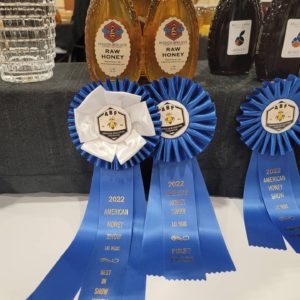
At the 2022 American Beekeeping Federation Honey Show this January, Mission Beelieve won some national recognition that they have proudly brought right back here to Maryland! The group won Best in Show as well as First and Second Place ribbons. Their honey was later auctioned off, raising a total of $3,200!
ABF took place at the South Point Hotel Casino and Spa in Las Vegas from January 5-8, and a team of dedicated volunteers from Mission Beelieve, led by co-founder Monica Schmitt, participated.
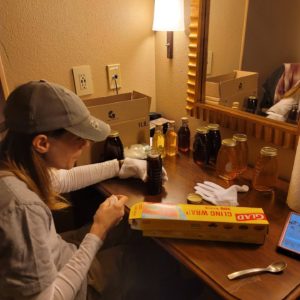
Many of us are familiar with the last minute prep a high level entry requires! For those who are not already familiar with this dynamic organization, Mission Beelieve provides a beekeeping education for local Veterans and First Responders. Their goal is to create a relaxing environment, while educating about the vocational aspects of beekeeping. This program gives a sense of purpose and a way to reconnect with the community.
About the win, cofounder Monica Schmitt says, "I can't contain my excitement! We have worked so hard to achieve these ribbons. We worked tirelessly this past year I wasn't sure if I would have time to get these entrees put together."
She says, "What did I do my first night in Vegas? I prepped for the honey show! I hoped to bring a ribbon home for our partners who played a roll in the whole process."
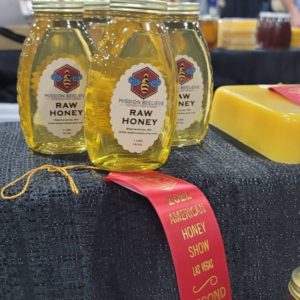
"I guarded three buckets of honey that our Veterans and First Responders extracted. I knew these buckets were special and that they were for competition. I'm so proud of our Partners with Mission Beelieve this win is for all of you."
"Everyone never stop Beelieving!"
Beekeeping Humor
- Beekeeping Smiles for Winter 2022
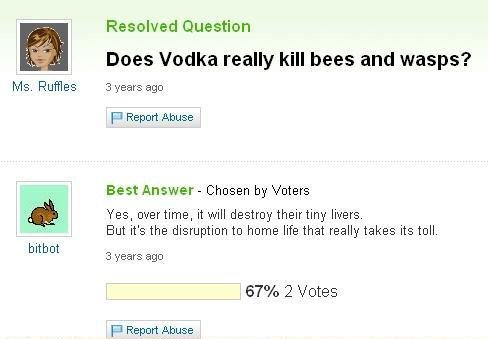
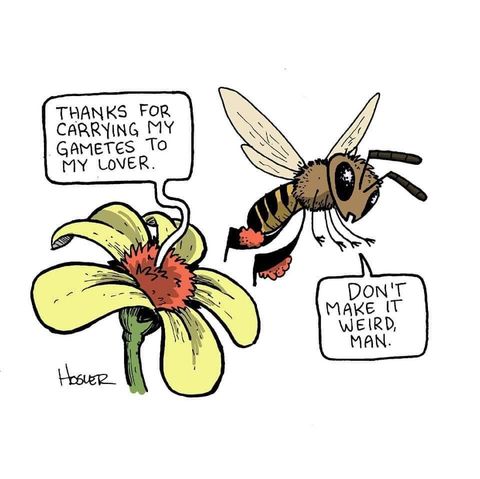
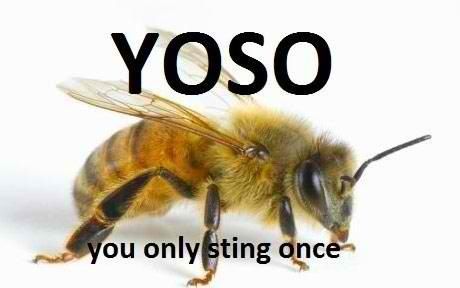
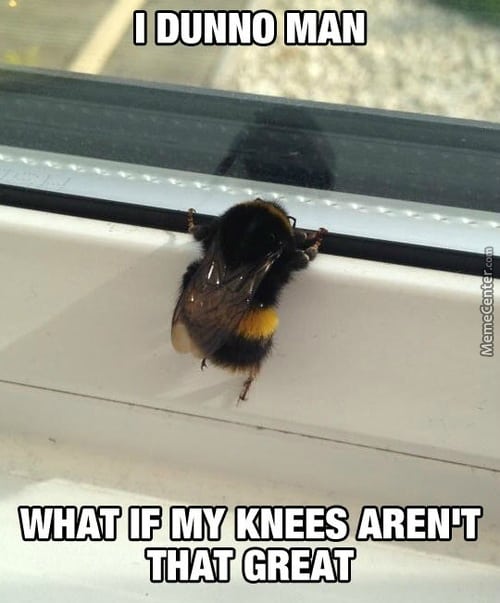
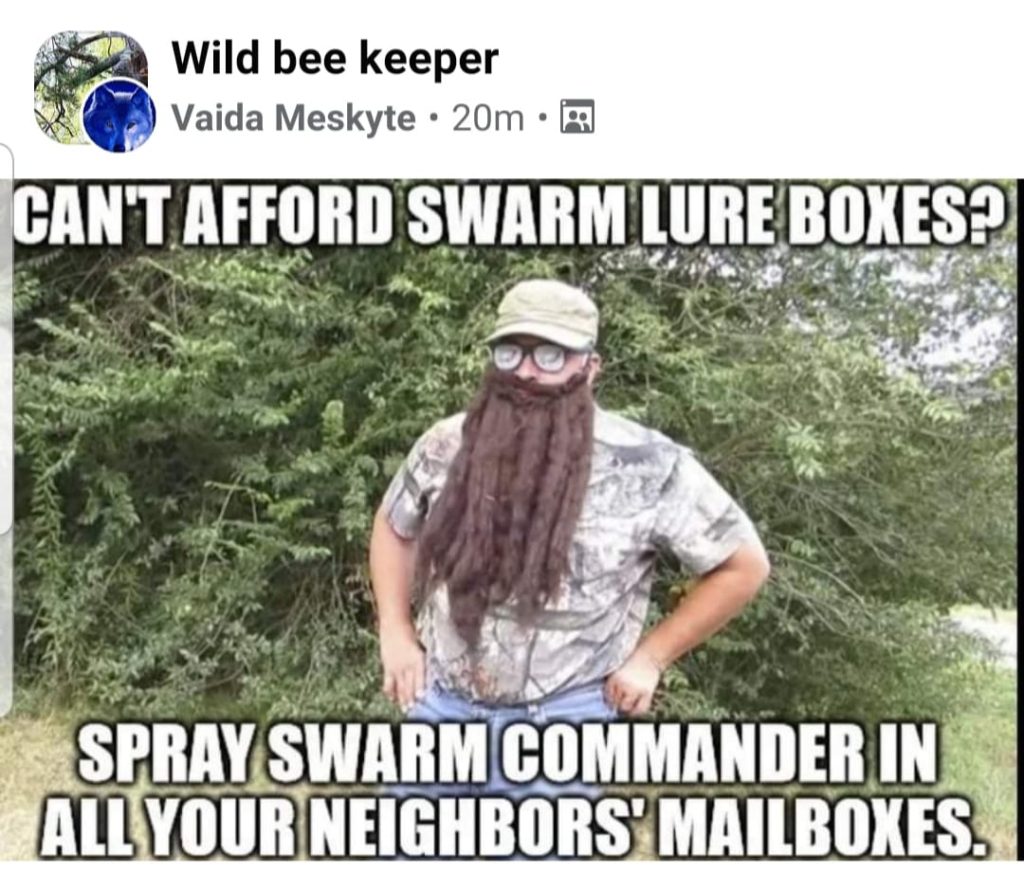
Bad Bee Jokes
A bee is riding on the back of a fly. The fly turns around, and asks, "Hey, are you a bee?"
To which the bee replies: "I might bee.
The fly then says, "Dude, that's the worst pun I have ever heard."
The bee responds, "I know man, I made it up on the fly."One day, two bees are buzzing around what's left of a rose bush.
"How's your summer been?" asks bee number one.
"Not too good," says bee two. "Lotta rain, lotta cold. There aren't enough flowers, therefore not enough pollen."
The first bee has an idea. "Hey, why don't you go down to the corner and hang a left? There's a bar mitzvah going on. Plenty of flowers and fruit."
Bee two buzzes, "Thanks!" and takes off. An hour later, the bees bump into each other again.
"How was the bar mitzvah?" asks the first bee.
"Great!" replies the second.
The first bee, however, notices a small circle on his friend's head, and inquires, "What's that on your head?"
"A yarmulke," is the answer. "I didn't want them to think I was a Wasp."A stingy old beekeeper figured out a way to take his money with him when he died. Not that he, a beekeeper, had a lot of money, but what he did have was going to join him in his afterlife. He instructed his wife to go to the bank and withdraw enough money to fill two pillow cases. He then directed her to take the bags of money to the attic and leave them directly above his bed. His plan: When he passed away, he would reach out and grab the bags on his way to heaven. Several weeks after the funeral, his widow was up in the attic cleaning, and came upon the two forgotten pillow cases stuffed with cash.
“Oh, that darn fool,” she exclaimed, “I knew he should have had me put the money in the basement.”
Beekeeping News and Notes
- Beekeeping News and Notes: February 2022
Honey bees increase social distance when facing Varroa
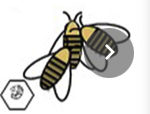 A recent study by Michelina Pusceddu of the University of Sassari, in Italy, and six colleagues found that honeybees in hives infected by parasites implement their own form of social distancing. To determine how Varroa changes bees’ behaviour, the authors set up six colonies, half of which were infected with the mite. They studied two common activities: the “waggle dance”, which forager bees perform to communicate the site of a newly discovered food source, and “allogrooming”, when bees clean debris or parasites (including mites) from each other’s bodies. The differences between the colonies were striking. In the Varroa-free group, waggle dances and allogrooming both occurred throughout the hive. By contrast, in infected colonies, most waggling occurred by the sides of the entrance, keeping potentially infected foragers far from brood cells. Conversely, allogrooming was concentrated in the centre of the hive, where parasite removal had the greatest impact. [More info]
A recent study by Michelina Pusceddu of the University of Sassari, in Italy, and six colleagues found that honeybees in hives infected by parasites implement their own form of social distancing. To determine how Varroa changes bees’ behaviour, the authors set up six colonies, half of which were infected with the mite. They studied two common activities: the “waggle dance”, which forager bees perform to communicate the site of a newly discovered food source, and “allogrooming”, when bees clean debris or parasites (including mites) from each other’s bodies. The differences between the colonies were striking. In the Varroa-free group, waggle dances and allogrooming both occurred throughout the hive. By contrast, in infected colonies, most waggling occurred by the sides of the entrance, keeping potentially infected foragers far from brood cells. Conversely, allogrooming was concentrated in the centre of the hive, where parasite removal had the greatest impact. [More info]
The Bees That Eat Corpses
A November 2021 article in Microbial Biology asks, "Why Did the Bee Eat the Chicken?" (this is a direct quote). In it, a team led by scientists Laura Figueroa and Jessica Maccaro of Cornell and USC/Riverside explore the biome of bees that switched back to being carnivores from the vegetarian lifestyle of the vast majority of bees. Researchers found that vulture bees lost some ancestral “core” microbes, retained others, and entered into novel associations with acidophilic microbes, which have similarly been found in other carrion-feeding animals such as vultures, these bees’ namesake. There is an accurate, entertaining and short Youtube video available from SciShow that digs into how the bee microbiome works, and is worth a view!
Learning and Inspiration from Forest Bees
Brand new from Princeton University Press, Wild Honey Bees is a beautiful scientific and photographic study of German forest bees that offers insights even to beekeepers who have read 'em all.
While the astonishing macro photography will reach into (and beyond) areas familiar to keepers of managed bees, the authors, Into Arndt and Jürgen Tautz, capture bees working in natural settings that can inform (and yes, amaze) those of us working in backyard or urban settings. As many of us grapple with finding practices that support bees' evolutionary adaptations to pets and disease control, the book describes an entire ecosystem that works with the bees (as they work) to create sustainable, remarkable, inspiring natural systems of bee health. What if we could have book scorpions riding the backs of our bees, right?
Understanding the Waggle Dance from the Inside: Looking at RNA
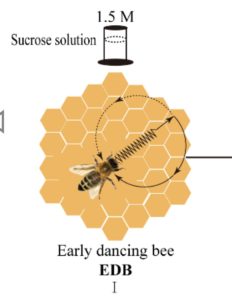
Scientists from Fujian Agriculture and Forestry University (China) and University Toulouse III (France) have collaborated to study the regulatory mechanisms underlying the waggle dance. Though the dance itself has been deeply studied, and of course decoded, it is not well understood how the bees' brains produce and are able to interpret the dance.
By varying the quality of the nutrition given to bees, the scientists were able to alter the quality and effectiveness of their communication. This points at the role of RNA (specifically non-coding RNA) on the target genes. The results indicated that lncRNAs in brains of waggle dancers and non-dancing bees exhibited significant differences.
In studies of humans, it has been shown that poor nutrition or other environmental variables can inhibit or damage gene expression: a function of the way in which RNA dictates how genes can perform.The results of RNA sequencing indicated that a total of 2877 lncRNAs and 9647 mRNAs were detected from honey bee brains. A first in this area, the study is expected to open a new pathway to research on the relationship of behavior and the brain.
Testing new compounds for efficacy against Varroa and safety to honey bees

"carbamate 2" A team led by Cameron Jack of the University of Florida led a study on new acaricides (chemicals used for control of Varroa destructor), noting that increased resistance to existing treatments drives the search for new, safe alternatives. The team looked at toxicity to mites (desired) versus to honeybees (undesirable) and assessed each.
Among the chemicals tried, amitraz remained the most toxic for varroa, but one of the "carbamate" compounds was found to be almost has toxic to varroa but much less so to honey bees. Additional testing is required to determine if 2-(2-ethylbutoxy)phenyl methylcarbamate can be used as an effective Varroa control.
Winter Meeting 2022 Information
- 2022 February 12 Meeting
WHERE: RECORDING AVAILABLE!You must be logged in to view the recording.
Please login and return to this page to access the view button. Thanks!
WATCH OUR MEETING - LEARN SOMETHING NEW!
CAMERON JACK will present two talks:
+ Principles of Integrated Pest Management (IPM)
- Specific examples of Varroa and Small Hive Beetle (SHB) management
- How IPM fits your honey bee management regimen
- How IPM can be PROFITABLE for you+ Cameron's Own Research To Fight Varroa
- How Cameron screens new chemicals against Varroa
- Why finding treatments is so difficult
- What doe the future hold for research
DAVID BURNS will present two talks:
+ Honey Bee Nutrition Through The Seasons
- Feeding specifically to obtain specific behaviors
- How to avoid the dangers of protein deprivation
- The critical season to feed bees+ Preparing For Spring Management
- Feeding in late winter and early spring
- Swarm prevention
- Making Splits
BIO for Cameron Jack:
Cameron Jack grew up in a small rural farm town called Logandale, NV, just outside of the lights and glitter of Las Vegas. His Grandpa was a high school principal, but supplemented his income through beekeeping, managing about 150 hives for honey production and pollination. Cameron grew up around honey bees and beekeeping, often helping his grandfather with hive inspections and honey extraction. He obtained his B.S. degree in biology from Southern Utah University in 2012 and completed his Master’s degree at Oregon State University under the mentorship of Dr. Ramesh Sagili in 2015. There he conducted research on the honey bee gut pathogen Nosema ceranae. He then traveled across the country to pursue a Ph.D. at the University of Florida under the mentorship of Dr. Jamie Ellis where he began investigating methods to control the devastating pest Varroa destructor.

Cameron Jack In 2018, Cameron was hired on as a teaching faculty at the University of Florida’s Entomology and Nematology Department. In the past three years, he has been obsessed with creating a premier educational program that prepares students for the many challenges associated with beekeeping and to train those interested in entering the beekeeping workforce. Cameron currently teaches seven honey bee-related courses and is now creating an online beekeeping certificate program. In the summer of 2021, transitioned into an Assistant Professor position focusing on Honey Bee Toxicology.
Most recently his projects have involved studying the efficacies of different chemical treatments to Varroa in field trials. Notably, his work on oxalic acid vaporization has been of interest to beekeepers around the world. He is also involved in a large-scale collaborative project screening a wide variety of untested chemicals for their toxicity towards Varroa and their effect on honey bees. As often as possible, Cameron tries to support undergraduate and graduate students with their research questions and helps them conduct meaningful studies that contribute to the overall scientific body of knowledge.
BIO for David Burns:

David Burns David Burns began beekeeping in 1994 after hiving a swarm from a fallen tree. After moving those hives from Ohio to Illinois, the hives were lost due to mites, and the yard had to be started all over again. In the beginning the Burns family just sold honey, but as time went on and the yard became bigger, the Burns family began building their own hives and selling them to other beekeepers. Knowing that the success of beekeepers was all dependent upon education, David began blogging and uploading videos to YouTube. In order to make sure beekeepers had the best and latest of scientific information on bees and beekeeping, David took several years to become a Certified Master Beekeeper. A graduate of Lincoln Christian University, and now a Master Beekeeper through the Eastern Apicultural Society since 2010, workshops on beekeeping are taught all year at the Training Center in Fairmount, IL. He also has a mentorship program, talks throughout the country at beekeeping association meetings, and heard frequently on radio shows and podcasts. He is also a competitive sportsman and competes throughout the US.
AGENDA
9:00 AM Welcome Fred Smith, MSBA President 9:15 AM Apiary Inspectors Report Cybil Preston, Chief MD Apiary Inspector 9:30 AM Preparing for Spring Management David Burns, EAS Master Beekeeper
honeybeesonline.com10:30 AM Break 11:00 AM A Comprehensive Overview of IPM Cameron Jack, University of Florida 12 Noon Lunch 1:00 PM Screening New Chemicals for Varroa Control Cameron Jack, University of Florida 2:00 PM
2:20 PMUMD Bee Squad Update
Sentinel Hive Program UpdateMark Dykes, University of Maryland
Nathalie Steinhauer, UMD vanEngelsdorp Lab2:50 PM Break 3:05 PM Honey bee Nutrition Through the Seasons David Burns, EAS Master Beekeeper
honeybeesonline.com4:00 PM Closing Questions and Answers Fred Smith, MSBA President


